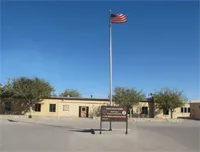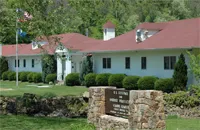Canine Center El Paso History
In 1986, after an alarming increase in illegal alien apprehensions and narcotics seizures, the senior leadership of the Border Patrol realized the need for detection dogs along our nation's borders. This realization led to the creation of a pilot program which consisted of four canine teams. These teams were trained at the Global Training Academy, located in San Antonio, Texas. The first four canines were trained to detect concealed humans, heroin, cocaine, methamphetamine, and marijuana. On April 18, 1987, these canine teams entered on duty. During the first five months of service, the four canine teams accounted for numerous apprehensions of concealed people and over $150,000,000 in seized narcotics. Due to the overwhelming realization of the impact a trained detection canine had on operations, by the end of 1988, the Border Patrol added 75 additional certified canine teams.

In order to establish consistency in training and certification standards, the U.S. Border Patrol began to explore the option of establishing its own canine training facility. Due to its central location along the southern border and a climate that is conducive to outdoor training year-round, a location on Biggs Army Air Field in El Paso, Texas was acquired by the U.S. Border Patrol. On March of 1993, the first instructor course "Detection Instructor Class I" began. By the end of the year, the U.S. Border Patrol's National Canine Facility (NCF) successfully completed two Detection Instructor/Handler Classes. As a result of these two classes, eleven instructor students and six handler teams graduated. At the time, the U. S. Border Patrol currently had 152 canine teams in the field which were supported by nine instructors.
As the U.S. Border Patrol grew, NCF experienced unprecedented growth. Through hard work and meticulous planning, the NCF staff created one of the finest canine training academies in the nation. Drawing from ideologies and disciplines from European working dog standards, the training at NCF received accolades and recognition from local, state, federal, and various international law enforcement agencies.
In the aftermath of the terrorist acts of September 11, 2001, the realignment of federal agencies and the creation of the Department of Homeland Security (DHS) thrust the Border Patrol Canine Program into uncharted territory. As a component of the newly formed U. S. Customs and Border Protection (CBP), NCF continued operating under the same principles that laid the foundation for its success: Honesty, Integrity, Leadership, and Focus on keeping the United States and its citizen's safe. In the fall of 2005, NCF was consolidated under CBP's Office of Training and Development (OTD) and renamed Canine Center El Paso (CCEP).
On October 1, 2009, the CBP Canine Program was created, merging CCEP with the Office of Field Operation's (OFO) Canine Center Front Royal under the direction of the newly established CBP Canine Program Headquarters.
To this day, CCEP carries on the tradition of producing the best field-ready canine teams under the direction of CBP Canine Program Headquarters.
Canine Center Front Royal
During the latter part of 1969, the former U.S. Customs Service carried out a study to determine the feasibility of using detector canines in the fight against drug smuggling. As a result, canine trainers from various branches of the U.S. military were recruited, and on April 1, 1970, the U.S. Customs narcotic detector dog training program was established at the Lackland Air Force Base in San Antonio, Texas. Initially, efforts were concentrated on training dogs to detect the odors of marijuana and hashish, but the immediate success, combined with the ever increasing smuggling of narcotics, would make the detection of heroin and cocaine equally critical in the war on drugs.

In July 1974, the detector dog training operation was relocated from San Antonio to its current location 70 miles west of Washington, D.C. in the town of Front Royal, Virginia. There, in the middle of the Shenandoah River Valley, sits 300 acres of property formerly used as a beef cattle research facility, and prior to that, functioned as a U.S. Cavalry remount station. The facility originally consisted of several hay barns, cattle stalls, large pastures, and wooded areas which would all slowly be renovated into administrative offices, classrooms, and kennels. In 1991, Congress approved funding for the facility improvement plan and in 1993, the construction of a new 100-run kennel, academic building, small arms firing range, and vehicle training areas were completed. These new additions brought the detection program facility up to date as it continued to produce canines trained in disciplines such as pedestrian processing, and detecting the odors of narcotics, currency, firearms, and explosives.
On March 1, 2003, the Department of Homeland Security was formed and effectually combined the canine resources of the former U.S. Customs Service (now the Office of Field Operations - OFO), U.S. Border Patrol (USBP), U.S. Immigration and Naturalization Service (INS) and the Animal Plant Health Inspection Service of the U.S. Department of Agriculture (USDA), all under one new agency, U.S. Customs and Border Protection (CBP).
CBP took the best practices from the OFO and USBP canine programs, each rich with history, tradition, and success, and combined them into one standardized curriculum containing identical training philosophies and methodologies geared toward individual agency operational requirements. This compatibility strengthened CBP's ability to effectively deploy manpower to meet operational requirements regardless of mission and/or operational component; in effect, multiplying CBP's canine force through unification.
In October of 2009, the unified CBP Canine Program was instituted with two training delivery sites, the Canine Center Front Royal (CCFR), formerly OFO's Canine Enforcement Training Center, and the Canine Center El Paso (CCEP), formerly USBP's National Canine Facility.
CCFR possesses a unified training cadre consisting of OFO and USBP personnel who deliver training to integrated classes made up of OFO and USBP students from throughout CBP. These new canine teams continue to be trained in disciplines such as concealed human detection, pedestrian processing and detecting the odors of narcotics, currency, and firearms.
Today, the training staff at CCFR produces some of the best detection canines, certified canine instructors, and canine handlers in the world. CCFR employees continue a proud legacy, which began so long ago in the Shenandoah Valley, training canine teams in various disciplines, for multiple law enforcement agencies and foreign governments, with the capability of being deployed into a myriad of environments in support of CBP's global mission; protecting the United States from those that would do her harm.

